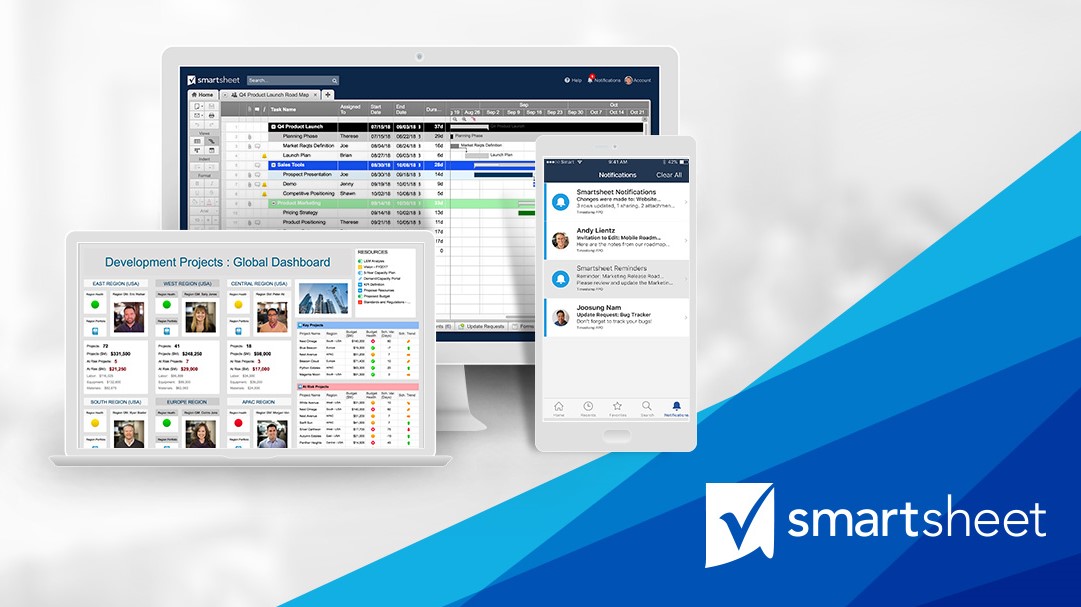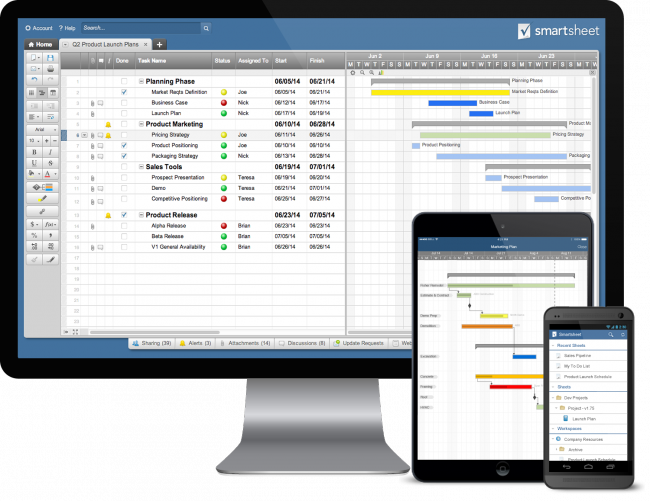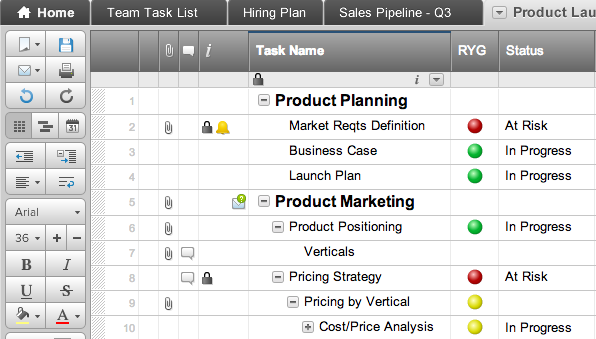This is the company Microsoft chose as partner to redefine collaborative work
Smartsheet builds on the spreadsheet paradigm by combining it with the power of the cloud

Smartsheet is looking to redefine the way that individuals, teams, and organizations deliver their best work. Its award-winning collaborative work management platform is trusted by over eight million registered users at 80,000 customers across more than 190 countries.
Customers like Cisco, Salesforce, the GSA, Google, and over half of the Fortune 500 use Smartsheet across a range of departments to create more than 10,000 new projects every day.
TechRadar Pro got in touch with the company to learn how it helps individuals and teams drive organisational speed and performance.
- We've also highlighted the best project management software
What are the big customer pain points that Smartsheet addresses?
Smartsheet is collaborative work management platform helping over 80,000 organizations and millions of people to deliver their best work. The company’s collaborative work management solution lets people manage work their way while at the same time making it simple to control their teams and processes.
The ease of use of the familiar spreadsheet-like interface, work automation and Gantt chart features, have made it a popular and highly functional collaboration and project management solution. Smartsheet is powering some today’s industry leaders – with a deep bench of successful startups, Fortune 100 brands, and half of the Fortune 500 – including: Airbnb, Uber, Netflix, Bayer, Cisco, Colliers International, BEHR, ESPN, and more. The company counts over eight million registered users as part of its ecosystem, across 190 countries and every industry.
The pain points that Smartsheet aims to address lie with the environment of modern workforce. Mountains of unstructured data combined with distributed teams and an unprecedented pace of work has created an urgent demand for software that quickly communicates the status of any kind of work. Smartsheet allows them to organize their work, assign accountabilities, track it to closure and keep the process transparent to the organization, with the ultimate goal of transforming seemingly unusable unstructured data, to actionable insights.
Smartsheet’s ideal customers are enterprise organizations looking for a way to better control their work and/or manage their teams, while having unparalleled visibility to make smarter business decisions.
Are you a pro? Subscribe to our newsletter
Sign up to the TechRadar Pro newsletter to get all the top news, opinion, features and guidance your business needs to succeed!
Given the ubiquity and widespread adoption of products like Microsoft Excel, what made you consider refining, and ultimately innovating, the spreadsheet in your early days?
Over 60 per cent of spreadsheets don’t contain a single formula. Initially designed for tracking finances, the spreadsheet’s simple interface has caused it to become the end user’s go-to tool for organization and management. Where most companies in the work management space attempt to completely alter this easy-to-use model, forcing users to work in the way that they believe is best, our Smartsheet founders saw the opportunity to build on the spreadsheet paradigm - combine it with the power of the cloud - to make work management simpler and easier. The founders at Smartsheet aimed to develop a platform that combines the best of both simple to use spreadsheets and powerful automation into one solution to help users manage their work.
Why did Microsoft choose to start working with Smartsheet, and how has the partnership grown?
Over the past few years, Microsoft has been investing heavily in their “Mobile first Cloud first” strategy, and have realized that they need to attract an ecosystem of SaaS ISVs to support their customer base. Smartsheet was a natural target for Microsoft given our heritage in the cloud and significant experience integrating with other cloud solutions such as Google Apps for Work. Smartsheet began working closely with Microsoft’s engineering teams in 2014 to start building new integrations and to provide feedback on what would work for our customers and technical infrastructure.
It’s been refreshing to work with Microsoft in such a close and open manner. We initially worked with the Azure team, then the Office team, and now also with the Power BI teams to get to where we are today.
How does Smartsheet’s platform integrate with Office 365, and other Microsoft cloud technologies?
Smartsheet integrates with Office 365 through its Smartsheet for Outlook application. Smartsheet for Outlook, allows users to manage their work in Smartsheet without leaving their Outlook inbox. Microsoft honored Smartsheet with “Best Microsoft Office 365 App” award for this integration at last year’s Worldwide Partner Conference (WPC 2015).
Additionally, Smartsheet integrates with Microsoft’s Azure Active Directory, providing single sign-on using work credentials, and Microsoft’s Power BI, which allows users to gain meaningful insights into their work and make better decisions. Power BI enables users to combine data in Smartsheet with outside data sources to create innovative visualization, while the content pack provides an interactive dashboard for the Smartsheet environment.
We continue to identify integration points to Office 365, Azure and other Microsoft technology, and are working closely with Microsoft engineering teams on the roadmap.
How could your collaboration with Microsoft be fueling the future of work and collaboration in the cloud?
The nature of work is rapidly changing. Employees are constantly on the lookout for technologies and products that make their work lives easier. On the other hand, executives and managers are driven by a need to foster collaboration among their teams/companies in an effective way. With Microsoft’s established enterprise credibility and Smartsheet’s cloud-based work management technology, the modern workforce is offered both the simplicity they desire, and the visibility and effectiveness needed to manage unstructured work in an effective way.

There have been countless work collaboration tools in the past. Why do you think most of them didn't achieve success?
Most tools either prescribe a fixed way to manage work or require significant technical resources to make them conform to how people want to work. Smartsheet lets people work their way without the need for technical resources so people actually use it.
Smartsheet’s spreadsheet-inspired interface, simple access to powerful project and process management functionality, and rich ecosystem of technology integrations have helped us become the preferred tool.
When it comes to productivity, collaboration and the shifting landscape of workers in today’s economy, can you provide your thoughts on what it will mean to be a “digital worker” over the next several years?
Research shows the number of digital workers will rise significantly in the near future, putting new stresses on cultures to work differently. To guide this transition, we expect to see the rise of an evolved role – the Informed and Empowered Connector (IEC) – a critical team player or manager that connects the work of others and sees a way to minimize busy work/avoid waste.
These individuals, constantly on the search for new technologies that can eliminate distractions, will completely shift the way organizations work and make decisions. Ultimately, when you look at the larger aggregate trends, today’s “digital worker” will largely continue to shift from BYOA (bring your own app) to BYOP (bring your own platform) over the next several years, underscoring the need for these IECs to connect with their employees/colleagues and identify areas of work that can be improved/streamlined by specific collaboration platforms.
Do you see more convergence happening over the next few years? Merging group comms with inbox and IM or content management?
Absolutely. As stated before, today’s (and tomorrow’s) workforce looks to streamline day-to-day activities and cut out the noise related to unnecessary apps that distract. We’re still in a “prove-it” mode in terms of the best way to collaborate and the best offerings will rise to the top, and others will die off. Trends like BYOP (bring your own platform) will continue to take organizations by storm.
Cloud apps that deliver platform benefits – those which satisfy multiple functions, support end user configuration, and align with IT standards, will begin to crowd out single purpose applications over time. This trend is further evidenced by larger players like Google and Microsoft doubling down on their efforts to partner with the best players in the collaboration space, furthering their goal of unifying the enterprise experience with both proprietary technology and strategic partnerships that add value to a consolidated ecosystem platform.

What are the fundamental differences between Microsoft Project and Smartsheet?
Microsoft Project is a great Enterprise Project Management tool, with a rich set of features and capability to drive large scale, complex enterprise initiatives and projects. However, with the increase of more unstructured work being done across non-traditional project management roles in business today, there is a need for a collaborative work management tool like Smartsheet that's cloud based, helps people work in a familiar spreadsheet based paradigm, and has extensive features that enable collaboration, accountabilities, sorting and tracking.
Customers use Smartsheet in a wide variety of use cases, from traditional Enterprise project management, to product launches, event management, incident tracking, etc. We also find that Smartsheet is used across various departments, right from the traditional engineering and execution teams, to non-traditional project management teams like marketing, sales, HR and operations. Hence, customers now have a choice of tools for the job at hand, depending on the scale, complexity, speed to value and feature set requirements for the job at hand.
- Get your projects under control with our top picks for the best project management software

Désiré has been musing and writing about technology during a career spanning four decades. He dabbled in website builders and web hosting when DHTML and frames were in vogue and started narrating about the impact of technology on society just before the start of the Y2K hysteria at the turn of the last millennium.